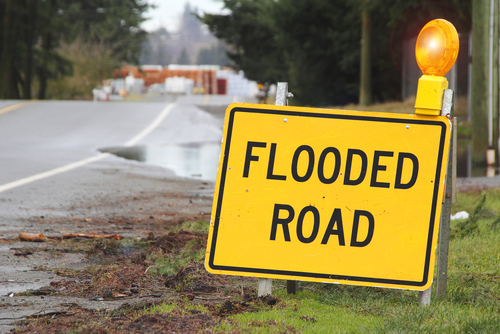
With Hurricane Harvey weighing on the minds and hearts of all Americans this week, we wanted to take some time to talk about flooding and flood safety. In a critical situation, being informed can be the difference between life and death.
Don’t Underestimate the Force of a Flooded Roadway
On average, nearly 100 people will drown every year in hazardous flood waters. The National Weather Service reports that more than half of those often-preventable deaths will be caused by motorists trying to drive a vehicle through flooded roads when they are quickly swept downstream. These drivers will underestimate the force and power of flood waters, ignore flood area signage, and continue to drive around the barriers that warn them that the area is flooded and a driving hazard. It will take just 12 inches of rushing water to carry away a small car, and two feet of calm rushing water can carry away most vehicles and their passengers into treacherous flooded waters.
Knowing how to protect yourself and loved ones from the driving dangers of floods before, during and after can save lives, reduce injuries and property damage.
Be Prepared: A Flood Watch vs. Flood Warning
What is the difference between a Flood Watch and a Flood Warning issued by the National Weather Service?
- Flash Flood Warning: Take Action! A Flash Flood Warning is issued when a flash flood is imminent or occurring. If you are in a flood prone area, you should move immediately to high ground. A flash flood is a sudden violent flood that can take from minutes to hours to develop. It is even possible to experience a flash flood in areas not immediately receiving rain.
- Flood Warning: Take Action! A Flood Warning is issued when the hazardous weather event is imminent or already happening. A Flood Warning is issued when flooding is imminent or occurring.
- Flood Watch: Be Prepared: A Flood Watch is issued when conditions are favorable for a specific hazardous weather event to occur. A Flood Watch is issued when conditions are favorable for flooding. It does not mean flooding will occur, but it is possible.
- Flood Advisory: Be Aware: A Flood Advisory is issued when a specific weather event that is forecast to occur may become a nuisance. A Flood Advisory is issued when flooding is not expected to be bad enough to issue a warning. However, it may cause significant inconvenience, and if caution is not exercised, it could lead to situations that may threaten property or even life.
Washed Away Roads and Buoyancy Create a Nasty Trap For Small and Large Vehicles Alike
Some drivers will assume that because they are driving a heavy duty or high-powered vehicle they can travel safely through flooded areas of the road. This is false. Rushing waters can undermine the integrity of a road, leaving most motorists unaware of what they are driving on and at risk of washing away once the concrete gives. These bulky vehicles, including trucks and other large sports utility vehicles, are also not too heavy to be swept away. Heavy vehicles will float, just like small, lightweight cars. In fact, the buoyancy factor (when the buoyant force is greater than the vehicle’s weight) the vehicle will then be controlled with the moving water and rush most vehicles away in 18-24 inches of moving water. Most drivers will start to lose control in just six inches of flood water though so it’s best to just not drive through flooded areas.
National Weather Service Has This Message: Turn Around, Don’t Drown
The National Weather Service says it is NEVER safe to drive into flood waters or around a flood zone barricade, instead Turn Around, Don’t Drown! Water may be deeper than it appears and can hide many hazards. Follow these directions from the National Weather Service if no alternate route exists or you have no choice but to drive through standing water:
- Of course, DIAL 911 if you find yourself in an emergency situation or need to report severe injuries. Otherwise, stay off of the telephone and away from other driving distractions.
- Drive slowly and steadily through the water.
- Do your best to estimate the depth of the water (if other cars are driving through, take note of how deep the water is).
- Avoid driving in water that downed electrical or power lines have fallen into — electric current passes through water easily.
- Watch for items traveling downstream, including small boats or people attempting to flee the area by swimming through the waters.
- If you have driven through water up to the wheel rims or higher and are safely out of the watered roadway, test your brakes on a clear patch of road at low speed. If they are wet and not stopping the vehicle as they should, dry them by pressing gently on the brake pedal with your left foot while maintaining speed with your right foot.
- If your vehicle stalls in the deep water, you may need to restart the engine to make it to safety. Keep in mind that restarting may cause irreparable damage to the engine.
If you lose control of your vehicle and you become trapped in rising water, immediately abandon it for higher ground. Try to open the door, sun roof or roll down the side window to get out of the vehicle. If you are unable to get out safely, call 911 or get the attention of a passerby or someone standing on higher ground so that they may call for help.
Recognize Warning and Incident Road Signs
One of the best ways to avoid being in a situation where you are trapped in your vehicle on a flooded roadway is to pay attention to the warning and flood reporting signs and be aware of what you may be traveling through. The National Weather Service worked closely with the Department of Transportation Federal Highway Administration to develop two officially sanctioned road signs used during flooding. Kentucky officials are encouraged to use these signs to mitigate the loss of life and property.
Warning Signs
Warning signs are permanent signs alerting drivers to existing or potentially hazardous road conditions. The warning signs are used in locations where the risk for flooding is high, flooding happens very quickly, and/or where flooding occurs in isolated locations when emergency officials don’t have time to post an incident sign.
Incident Signs
Incident signs are temporary signs posted on an as-needed basis. Incident signs should be deployed when a natural disaster (flood or flash flood) or other unplanned event impedes the normal ow of traffic.
If you and your family are in a situation where a flood has impacted your life and you are struggling to deal with insurance claims for doctor and hospital bills, loss of property, loss of life and other legal documents, Rhoads & Rhoads can help guide you. Our clients pay no fees up front for consultation or investigation of claims. Call us today at 888-709-9329—we’ll help you take care of the rest.


